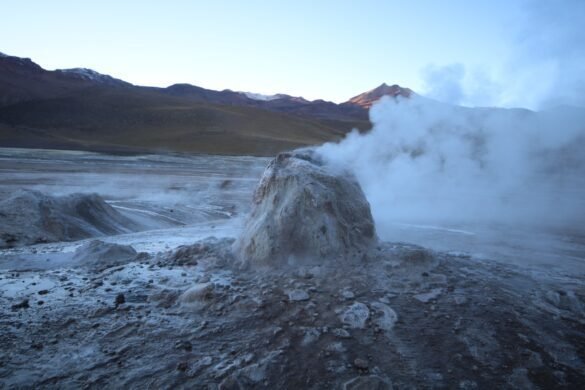Table of Contents
How Hot Springs and Geysers are Formed
Hot springs and geysers are natural phenomena that occur when water is heated by geothermal energy below the Earth’s surface. They are often found in regions of volcanic activity, where magma or hot rocks provide the heat source.
Hot springs and geysers differ in the way they release the heated water to the surface. Hot springs are steady flows of warm or hot water, while geysers are intermittent eruptions of water and steam.
Formation of Hot Springs
Hot springs form when rainwater or groundwater seeps into the ground and reaches a depth where it is heated by geothermal energy. The heated water then rises back to the surface through cracks or faults in the Earth’s crust, or through porous rocks that allow water to flow. The temperature of the water depends on the depth and distance from the heat source, as well as the rate of flow and cooling. Some hot springs can reach temperatures above 100 °C (212 °F), while others are only slightly warmer than the surrounding air.
Hot springs can have various chemical compositions, depending on the minerals dissolved in the water and the gases released from the magma or rocks. Some hot springs are rich in sulfur, iron, calcium, sodium, or other elements, giving them different colors and smells. Some hot springs also contain beneficial microorganisms that thrive in extreme conditions. These microorganisms can produce pigments, enzymes, or antibiotics that add to the diversity and value of hot springs.
Uses and Examples of Hot Springs
Hot springs have been used for various purposes throughout history and across cultures. Some of the most common uses are:
Recreation:
Many people enjoy bathing or swimming in hot springs for relaxation, health, or pleasure. Some hot springs have been developed into spas, resorts, or pools that offer various amenities and services. Some examples of popular hot spring destinations are Yellowstone National Park in the US, Beitou District in Taiwan, and Onsen in Japan.
Medicine:
Some people believe that hot springs have healing properties, due to their high mineral content, temperature, or microorganisms. Some hot springs are used to treat skin diseases, rheumatism, arthritis, or other ailments.
Some examples of medicinal hot springs are Blood Pond in Japan, which has a high concentration of iron and a bright red color; Elizabeth Spring in Australia, which has a high concentration of radium and was used to treat cancer; and Glenwood Spring in the US, which has a high concentration of lithium and was used to treat mental disorders.

Energy:
Some hot springs can be used as a source of renewable energy, by harnessing their heat to generate electricity or provide heating. This process is called geothermal energy, and it involves drilling wells or pipes into the ground to access the hot water or steam.
Some examples of geothermal power plants are Lava Hot Spring in Iceland, which produces about 25% of the country’s electricity; El Tatio in Chile, which is the largest geothermal field in South America; and Taupo Volcanic Zone in New Zealand, which is one of the most active geothermal areas in the world.
Formation of Geysers
Geysers are a special type of hot spring that erupt periodically with water and steam. Geysers form when water is trapped in underground chambers that are connected to narrow conduits that reach the surface. The water in the chambers is heated by geothermal energy until it reaches a boiling point.
The boiling water creates pressure that pushes some of the water up the conduits, creating a geyser eruption. The eruption lasts until the pressure is released and the water level drops in the chambers. The cycle then repeats as more water fills up the chambers and is heated again.
The frequency and duration of geyser eruptions depend on several factors, such as:
- The size and shape of the chambers and conduits
- The amount and temperature of the water supply
- The amount and temperature of the heat source
- The amount and type of dissolved minerals and gases
- The atmospheric pressure and weather conditions
Examples of Geysers
Geysers are rare formations that are only found in a few places around the world. Some of the most famous geysers are:
- Old Faithful in Yellowstone National Park, which is one of the most predictable geysers in the world, erupting every 60 to 110 minutes with an average height of 40 m (131 ft).
- Strokkur in Iceland, which is one of the most active geysers in the world, erupting every 5 to 10 minutes with an average height of 20 m (66 ft).
- Valley of Geysers in Russia, which is the second largest concentration of geysers in the world, with about 90 geysers and many hot springs in a 6 km (3.7 mi) long valley.
- Waimangu Geyser in New Zealand, which was the largest geyser ever recorded, erupting up to 460 m (1,509 ft) high in the early 20th century, before becoming dormant in 1904.
Conclusion – How Hot Springs and Geysers are Formed
Hot springs and geysers are fascinating natural phenomena that showcase the power and diversity of geothermal energy. They are also valuable resources that can be used for various purposes, such as recreation, medicine, or energy.
However, they are also vulnerable to human interference and environmental changes, such as pollution, overexploitation, or climate change. Therefore, they need to be protected and conserved for future generations to enjoy and benefit from.
